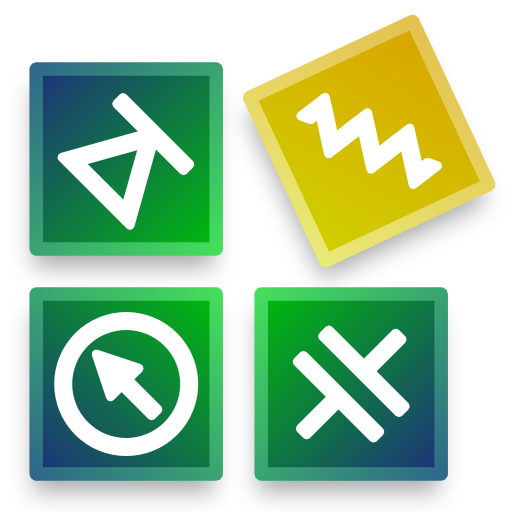

Droid Tesla Pro
工具 | Vladimir Djokic Djole
在電腦上使用BlueStacks –受到5億以上的遊戲玩家所信任的Android遊戲平台。
Play Droid Tesla Pro on PC
DroidTesla is a simple and powerful circuit simulator.
Perfect for students new to electronics circuit design and construction,
hobbyist and tinkerers and even seasoned professionals who want a quick,
handy tool to perform electronics circuit design calculations.
That's interactivity and innovation you can't find in best SPICE tools for PC like Multisim, LTspice, OrCad or PSpice (trademarks belong to their respective owners).
DroidTesla simulator solves basic resistive circuits using Kirchoff’s Current Law (KCL)
in much the same way a student in a circuits class would,the simulator systematically forms a matrix in accordance
with KCL and then proceeds to solve for the unknown quantities using various algebraic
techniques such as Gaussian elimination and sparse matrix techniques.
For non-linear components, such as the diode and BJT ,DroidTesla engine searching for the approximate solution by making an initial guess at an answer
and then improving the solution with successive calculations built upon this guess.
This is called an iterative process.DroidTesla simulation uses the Newton-Raphson iterative algorithm
to solve circuits with non-linear I/V relationships.
For reactive elements(capacitors and inductors),the DroidTesla uses numeric integration methods to approximate the state of the reactive elements as a function of time.
DroidTesla offers the Trapezoidal(I'll add a GEAR method later) integration methods to approximate the state of the reactive elements.
Although for most circuits, both methods will provide almost identical results,
it is generally regarded that the Gear method is more stable, but trapezoidal method is faster and more accurate.
DroidTesla for now can simulate:
-Resistor
-Capacitor
-Inductor
-Potentiometer
-Light Bulb
-Ideal operational amplifier
-Bipolar junction transistor (NPN PNP)
-MOSFET N-channel depletion
-MOSFET N-channel enhancement
-MOSFET P-channel depletion
-MOSFET P-channel enhancement
-JFET N and P
-PN Diode
-PN Led diode
-PN Zener diode
-AC current source
-DC current source
-AC voltage source
-DC voltage(battery) source
-CCVS - current controlled voltage source
-CCCS - current controlled current source
-VCVS - voltage controlled voltage source
-VCCS - voltage controlled current source
-Square wave voltage source
-Triangle wave voltage source
-AC ampermeter
-DC ampermeter
-AC voltmeter
-DC voltmeter
-Two channe oscilloscope
-SPST Switch
-SPDT Switch
-Voltage controlled switch
-Current controlled switch
-AND
-NAND
-OR
-NOR
-NOT
-XOR
-XNOR
-JK flip-flop
-7 Segment Display
-D flip-flop
-Relay
-IC 555
-Transformer
-Graetz Circuit
If you are making an
oscillators you have to put a small initial value on some of the
reactive elements.(see the examples)
Perfect for students new to electronics circuit design and construction,
hobbyist and tinkerers and even seasoned professionals who want a quick,
handy tool to perform electronics circuit design calculations.
That's interactivity and innovation you can't find in best SPICE tools for PC like Multisim, LTspice, OrCad or PSpice (trademarks belong to their respective owners).
DroidTesla simulator solves basic resistive circuits using Kirchoff’s Current Law (KCL)
in much the same way a student in a circuits class would,the simulator systematically forms a matrix in accordance
with KCL and then proceeds to solve for the unknown quantities using various algebraic
techniques such as Gaussian elimination and sparse matrix techniques.
For non-linear components, such as the diode and BJT ,DroidTesla engine searching for the approximate solution by making an initial guess at an answer
and then improving the solution with successive calculations built upon this guess.
This is called an iterative process.DroidTesla simulation uses the Newton-Raphson iterative algorithm
to solve circuits with non-linear I/V relationships.
For reactive elements(capacitors and inductors),the DroidTesla uses numeric integration methods to approximate the state of the reactive elements as a function of time.
DroidTesla offers the Trapezoidal(I'll add a GEAR method later) integration methods to approximate the state of the reactive elements.
Although for most circuits, both methods will provide almost identical results,
it is generally regarded that the Gear method is more stable, but trapezoidal method is faster and more accurate.
DroidTesla for now can simulate:
-Resistor
-Capacitor
-Inductor
-Potentiometer
-Light Bulb
-Ideal operational amplifier
-Bipolar junction transistor (NPN PNP)
-MOSFET N-channel depletion
-MOSFET N-channel enhancement
-MOSFET P-channel depletion
-MOSFET P-channel enhancement
-JFET N and P
-PN Diode
-PN Led diode
-PN Zener diode
-AC current source
-DC current source
-AC voltage source
-DC voltage(battery) source
-CCVS - current controlled voltage source
-CCCS - current controlled current source
-VCVS - voltage controlled voltage source
-VCCS - voltage controlled current source
-Square wave voltage source
-Triangle wave voltage source
-AC ampermeter
-DC ampermeter
-AC voltmeter
-DC voltmeter
-Two channe oscilloscope
-SPST Switch
-SPDT Switch
-Voltage controlled switch
-Current controlled switch
-AND
-NAND
-OR
-NOR
-NOT
-XOR
-XNOR
-JK flip-flop
-7 Segment Display
-D flip-flop
-Relay
-IC 555
-Transformer
-Graetz Circuit
If you are making an
oscillators you have to put a small initial value on some of the
reactive elements.(see the examples)
在電腦上遊玩Droid Tesla Pro . 輕易上手.
-
在您的電腦上下載並安裝BlueStacks
-
完成Google登入後即可訪問Play商店,或等你需要訪問Play商店十再登入
-
在右上角的搜索欄中尋找 Droid Tesla Pro
-
點擊以從搜索結果中安裝 Droid Tesla Pro
-
完成Google登入(如果您跳過了步驟2),以安裝 Droid Tesla Pro
-
在首頁畫面中點擊 Droid Tesla Pro 圖標來啟動遊戲



